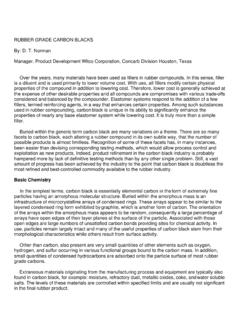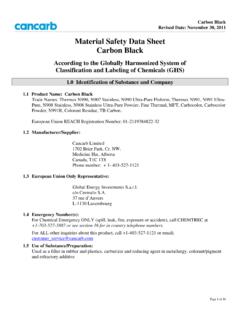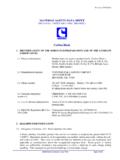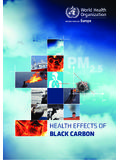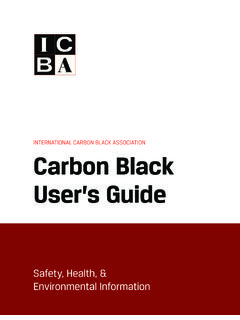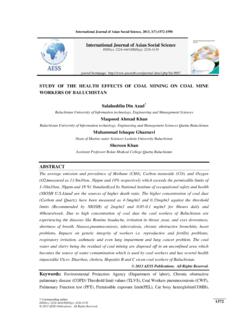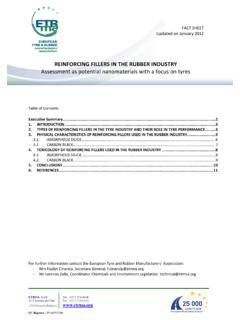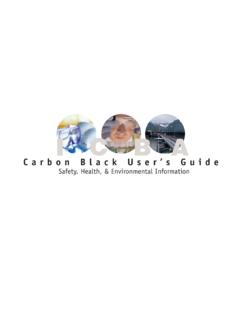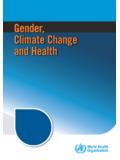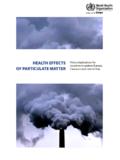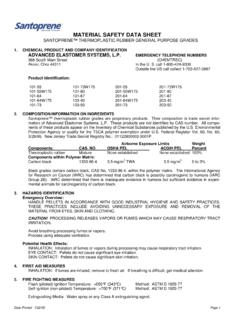Transcription of Safety Data Sheet Carbon Black - Continental Carbon
1 Safety data Sheet Carbon Black According to the Globally Harmonized System of Classification and Labeling of Chemicals (GHS) Revision 5 1. IDENTIFICATION GHS Product Identifier Carbon Black Trade Names: Thermax * N990, Thermax N907 Stainless, Thermax N990 Ultra Pure, Thermax N991 Powder, Thermax N991 Powder Ultra Pure, Thermax N908 Stainless Powder, Thermax N908 Stainless Powder Ultra Pure, Fine Thermal, MFT, Carbocolor , Carbocolor Powder, TB Carbon . *For a complete list of Cancarb s trademarks and the countries where they are registered go to European Union REACH registration number: 01-2119384822-32 Other Means of Identification N/A Recommended Use of the Chemical and Restrictions on Use Used as a filler in rubber and plastic products, a colorant/pigment, a carburizer and reducing agent, and refractory additive.
2 Not recommended as a human tattooing pigment. Supplier s Details Cancarb Limited 1702 Brier Park Crescent NW. Medicine Hat, Alberta Canada, T1C 1T9 Phone number: + Email: European Union Only Representative: WIL Research Hambakenwetering 7 5231 DD s-Hertogenbosch The Netherlands 1 Carbon Black Revised Date: May 25, 2015 Emergency Phone Number : CHEMTREC (chemical emergencies only): CANADA: CANUTEC: 1. Cancarb Limited + or email: Hours: 8:00am 4:00pm 2. HAZARD INDENTIFICATION Classification of the Substance or Mixture According to the criteria in OSHA HCS (2012) for classifying hazardous substances, Carbon Black is not classified for any toxicological or eco-toxicological endpoint.
3 As a combustible dust it is designated by OSHA as a hazardous chemical. See Labelling and Hazards Not Otherwise Classified (HNOC) . According to the criteria in GHS (UN) for classifying hazardous substances, Carbon Black is not classified for any physico-chemical, toxicological or eco-toxicological endpoint. See , Other hazards which do not result in classification According to the criteria in Regulation (EC) No. 1272/2008 (CLP) for classifying hazardous substances, Carbon Black is not classified for any physico-chemical, toxicological or eco-toxicological endpoint.
4 According to the criteria in Canadian Hazardous Product Legislation known as Worker Hazardous Material Information System (WHMIS) Carbon Black is not classified for any health hazards. Carbon Black is classified as a Combustible Dust. GHS Label Elements, Inc luding Precautionary Statements WARNING: May form explosible dust-air mixture if dispersed. Keep away from all ignition sources including heat, sparks and flame. Prevent dust accumulations to minimize explosion hazard. Control dust exposures to below applicable occupational exposure limits.
5 Hazards Not Otherwise Classified (HNOC) This substance is classified as hazardous as a combustible dust by the United States 2012 OSHA Hazard Communication Standard (29 CFR ) and the Canadian Hazardous Products Regulation (HPR) 2015. Do not expose to temperatures above 400 C. Hazardous products of combustion can include Carbon monoxide (CO), Carbon dioxide (CO2), oxides of sulfur, and organic products. Principle Routes of Exposure: Inhalation, Eye contact, Skin Contact Eye Contact: May cause mechanical irritation. Avoid contact with eyes.
6 2 Carbon Black Revised Date: May 25, 2015 Skin Contact: May cause mechanical irritation, soiling, and skin drying. Avoid contact with skin. No cases of sensitization in humans have been reported. Inhalation: Dust may be irritating to respiratory tract. Provide appropriate local exhaust ventilation at machinery and at places where dust can be generated. See also Section 8. Ingestion: Adverse health effects are not expected. See Section 11. Carcinogenicity: Carbon Black is listed as an IARC (International Agency for Research on Cancer) Group 2B substance (possibly carcinogenic to humans).
7 See also Section 11. Target Organ Effects: Lungs, See Section 11 Medical Conditions Aggravated by Exposure: Asthma, Respiratory disorder Potential Environmental Effects: None known. See Section 12. 3 COMPOSITION / INFORMATION ON INGREDIENTS Substances Carbon Black , amorphous (100% by weight) Chemical formula: C Common name(s), synonym(s) of the substance: Furnace Black , thermal Black , lamp Black , acetylene Black CAS number and other unique identifiers for the substance: CAS number: 1333-86-4 EINECS number: 215-609-9 Impurities and stabilizing additives which are themselves classified and which contribute to the classification of the substance Mixtures Not Applicable 3 Carbon Black Revised Date.
8 May 25, 2015 4 FIRSTAID MEASURES Description of Necessary First-aid Measures Inhalation As conditions permit move person to fresh air and restore normal breathing. Short-term exposures to concentrations that are well above the occupational exposure limit may produce temporary discomfort to the upper respiratory tract, which may result in coughing and wheezing. Removal from Carbon Black exposure is normally sufficient to cause symptoms to subside without lasting effects. Carbon Black is not a respiratory irritant, as defined by the Occupational Safety and Health Administration (OSHA) or UN GHS.
9 Skin Wash skin with mild soap and water. Carbon Black dust or powder may cause drying of the skin with repeated and prolonged contact. Carbon Black is not a chemical skin irritant. Treat symptomatically for mechanical irritation. Eye Rinse eyes with clean water keeping eyelid open. If symptoms develop seek medical attention. Carbon Black is not a chemical eye irritant. Treat symptomatically for mechanical irritation. Ingestion No adverse effects are expected from Carbon Black ingestion. Do not induce vomiting. First-aid responders should wear an approved respirator where airborne dust concentrations are expected to exceed occupational exposure limits.
10 Most important symptoms/effects, acute and delayed see inhalation above and Section 11. Indication of immediate medical attention and special treatment needed, if necessary see inhalation above. 5 FIRE FIGHTING MEASURES Suitable Extinguishing Media Use foam, Carbon dioxide (CO2), dry chemical, nitrogen (N2), or water fog. A fog spray is recommended if water is used. Do not use a high pressure water stream as this may spread burning powder (burning powder will float and may spread fire). Do not use a high pressure media which could cause the formation of a potentially explosible dust-air mixture.
